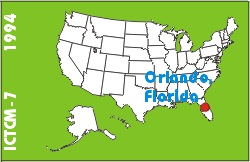
Electronic Proceedings of the Seventh Annual International Conference on Technology in Collegiate MathematicsOrlando, Florida, November 17-20, 1994Paper C019Examples of Graphing Calculator Use in Calculus I |
George EmeseDepartment of Mathematics Rowan College of New Jersey Glassboro, NJ 08028-1701 USA Phone: (609) 256-4500 x3886 Fax: (609) 256-4929 gemese@mars.rowan.edu |
| Click to access this paper: |
ABSTRACT
Recent breakthroughs in computing technology, interactive computer and calculator graphing, are becoming part of the mathematics instruction at the secondary and college level. Research shows that these technologies can be used successfully in mathematics education. They can open new horizons and they can revolutionize what and how we teach in mathematics [6, 7, 10, 12]. However, since these opportunities became available only recently, this is still a new, unexpected, unstudied, and unpredictable area in mathematics education, where there is a great need for further research [11].Learning by discovery, on the other hand, has been one of the most studied and most controversial issues in mathematics education [2, 5]. A great number of arguments have been given both for and against; a great number of experiments have been conducted. However, research results are still conflictive and inconclusive [2, 4, 5, 8, 9]. There were numerous calls for further research on the effectiveness of the discovery style teaching [1, 2, 13], particularly for research under regular classroom circumstances [3], dealing "with large segments of instructional material and not merely with short-term problem-solving exercises in the laboratory" ([1], p. 561). The development of interactive computer and calculator graphing gives new momentum to the discovery movement since it facilitates student experimentation and discovery.
This paper describes a three-group experimental study conducted in an introductory university differential calculus course at The Ohio State University with the following design.
| Group 1 | Use of graphing calculators + (guided) discovery approach |
|---|---|
| Group 2 | Use of graphing calculators without discovery |
| Group 3 | No graphing calculators, no discovery (traditional instruction) |
The two major objectives of the study were to verify that students can discover a significant portion of differential calculus and to investigate the effects of the use/non-use of graphing calculators and the instructional technique (lecture/discussion or guided discovery style teaching) on student achievement (conceptual understanding, ability to transfer what has been learned to a different but related situation, computational skills, short and long term retention), students' time spent on course, the extent to which students worked with classmates outside of class, and the extent to which students actually discovered the new material.
In the discovery section, part of the new material was covered using worksheets, where a chain of questions/problems led to the new concept, relationship, or technique. Students worked in groups, pairs or individually. The worksheets were supplemented with hint-sheets and solution-sheets (the latter with complete solutions, the former with some hints only). If students needed help they could look at these cheat-sheets, but only one line at a time, and then they were to continue on their own. They could also ask their classmates and/or the instructor. They were to check their answers after each problem using the solution-sheets and correct them if necessary. Obviously, students cannot discover everything mankind has discovered in 2000 years (especially not in 50 x 48 minutes); thus (the larger) part of the material was covered in the traditional discussion format.
According to the questionnaire students completed after the final exam, students found the answer on their own to 47% of those questions on the worksheets where the answer was not previously known to them. They found the answer to an additional 22% of the questions with hints from the hint-sheets, from classmates or the instructor. Over 75% of the students found the answer to the majority of such questions with or without hint. 88% of the students suggested that some classtime (in average 30%) be spent on discovery style teaching. This shows that discovery style teaching is a viable alternative to traditional teaching for at least part of the new material.
The groups were compared before and after instruction. No statistically significant differences were found on the computational, conceptual, and transfer skills parts of the pretest. No statistically significant differences were found on the following background variables either: placement level, the year in which students took the placement test, their precalculus grade and the year in which they took precalculus.
Analyses of covariance were used for student achievement comparisons. The scores on the corresponding subtest of the pretest served as covariates. Students' time spent on the course and the extent to which students worked with their classmates outside of class were also compared. Statistically significant differences were not found between the groups on any of these variables. No instructional method proved superior to the others on comparison.
A sample hint-sheet follows. The corresponding worksheet is identical, but without the hints written in Zapf Chancery font (imitating handwriting) and without the graph. The corresponding solution-sheet contains all the written text in Times font in the hint-sheet and complete solutions to all problems.
Keyword(s): graphing calculators, numerical methods, calculus
